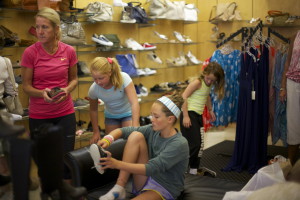Back-to-school shopping got an A-minus from retailers as more parents compared prices and cut back on buying.
Families with school-age children were expected to spend an average of $634.78 on apparel, shoes, supplies and electronics this year, down from $688.62 last year, according to a survey by Prosper Insights and Analytics for the National Retail Federation.
Total back-to-school spending for kindergarten through 12th grade was expected to reach $26.7 billion nationwide. Back-to-college spending was expected to reach $45.8 billion this year.
The reduction in shopping was attributed to an increase in prices.

In the past 12 months, prices of consumer goods rose 1.4 percent, and consumer spending fell flat last month after rising 0.2 percent in June, the Bureau of Economic Analysis reported. Consumer spending ticked up 0.1 percent last month, slowing from a 0.4 percent increase in June, according to the U.S. Commerce Department. Income ticked up 0.1 percent after rising 0.3 percent in June, which reflected a drop in hours worked and hourly earnings in the July employment report.
Nearly 77 percent of those polled in the back-to-school survey blamed the economy on their spending.
A sampling of shoppers in Westchester reflected the national trend, buying what their children absolutely needed.
At Shoes ”™N”™ More on Purchase Street in Rye, store manager Cheryl Zeitlin said this year, back-to-school spending decisions were based on what parents think their children need now ”“ not worrying about what they”™ll need later.
“Now people are buying one pair of shoes at a time instead of two or three,” Zeitlin said. “Parents won”™t buy kids boots until the winter, whereas before they would take care of all their shopping at once. They”™re watching their money and spreading out their spending.”
She said that more people were traveling for Labor Day this year than last year, so they had fewer shoppers over the weekend. The chain store based in Greenwich has locations in New Canaan, Westport, Ridgefield, Rye, New York City and Bronxville.
Port Chester mother Maura Semprevivo took her two daughters Lilly and Annie shopping for Sperry Top-Siders, a popular boat shoe brand that is in style among schoolchildren and college students this season. Her girls got to buy one pair of shoes each at Shoes ”™N”™ More for the school year.
“These girls come in here knowing what they want,” Semprevivo said. “But I tell them they both get one pair of Sperrys and one backpack for the year. If the backpack has no rips, then they have to use it again next year.”
Semprevivo said she has six children, and she hasn”™t gotten through their entire school supply list yet. She knows she won”™t be buying more than one pair of shoes per child this year. She said her average spending per child increased from five years ago during the recession, but remains level comparing this year to last year.
A few doors down Purchase Street, New York Running Company, a Princeton-based athletic footwear store with two locations in Manhattan, saw an influx of young athletes. District manager Tim Clark said the store provided discounts for kids”™ shoes for the back-to-school season and it has continued to increase sales since opening in Rye in 2011.
“The shoe industry is resistant to the lulls of other areas of retail, and we”™re lucky enough to be insulated from the ripple effects,” Clark said. “We”™ve experienced more customers spending relative to previous years.”
As e-commerce becomes an increasingly important component for retailers, most active shoe stores have gotten a website. Clark said New York Running Company is finally launching one, too. Before, the store relied on word of mouth and networking to tell customers about its personal services including a software program that monitors people”™s running behavior and gives customers feedback on where most of the pressure falls when they run. Now, Clark said he hopes to create a web presence that provides useful resources for its online community and helps streamline shoppers”™ purchases.
E-commerce will continue to drive sales for retailers, NPD Group, a global retail market research organization, reported.
“The online shopping growth rate is outperforming the brick and mortar experience,” Marshal Cohen, NPD Group analyst, said. “There are ways to sell products that are unique to the online experience. It”™s more resource-centric and you can have the convenience of knowing when the product is ready to ship. But of course the challenge is it”™s a 2-D process, and you can”™t touch and feel the merchandise.”
Cohen said more shoppers are using e-commerce to make back-to-school purchases, and retailers who have websites typically do better in sales than those who don”™t.
“Online isn”™t going to diminish yet,” Cohen said. “It”™s growing from a brand perspective. Almost every retailer has an online component.”


















